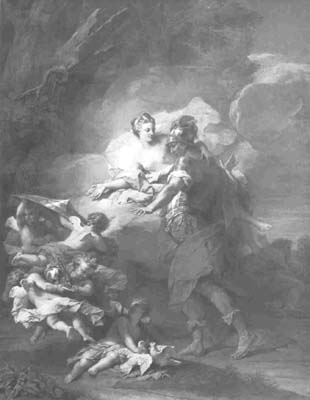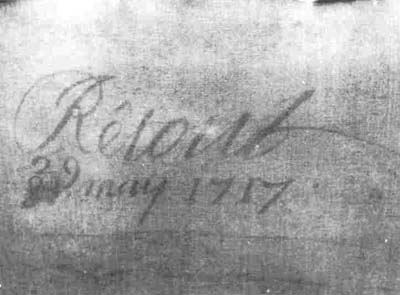
Annual Bulletin 6, 1982-1983
Home
Français
Introduction
History
Annual Index
Author &
Subject
Credits
Contact


Paintings
by Restout on Mythological and Historical Themes: Acquisition by the
National Gallery of Canada of Venus Presenting Arms to Aeneas
The information provided by J. B. Restout is found in the other
articles as well, although sometimes in a distorted form. Rouxelin
indicated correctly in May 1768: "The work that Mr Restout
submitted, not for purposes of the competition, but to find out
whether the masters of the art would advise him to continue in this
vein...won its author the honour of being admitted to the Academy as an associate member."
(3)
However, the February issue of the Mercure was more
ambiguous: "He became an associate member of the Academy in the
same year...on the basis of the work he submitted in competition
for the grand prize and the trip to Rome," (4) as was the Nécrologe in
1769. The April 1768 issue of the Journal des Sçavans contained
a strange article which showed ignorance of the customs of the
Academy: "Admitted to the Academy as an associate member...on
the basis of the work that he would submit in competition for the
grand prize, and on the condition that he would make the trip to
Rome." (5) And in August, Duboullay positively identified the
competition piece and the painting for which Restout was admitted as
an associate member:" And when he entered his first
competition for the Academy's prize, the Company - instead of
awarding him the prize - accepted him into the Academy and considered
the painting to be his reception piece." (6) However, even if we
assume that the word "reception" was used instead of "admission: this information is clearly incorrect.
In that
era, and especially in the case of the 1717 contest, the themes for
the grand prize were biblical. (7) The theme of the painting submitted to the Academy in 1717 is not mentioned either in any of these
articles or in the Academy's Procès-verbaux (8) contrary to
what was indicated in the 1970 exhibition catalogue. (9) The only place
the title appears is in the Galerie françoise, the indications of which must be taken literally:
Restout had thought about
entering the contest in 1717, but had not done so; the painting he
submitted for his admission to the Academy as an associate member
was merely a private exercise.
by Pierre Rosenberg and Antoine Schnapper
Article en français
Pages 1 | 2
| 3 | 4
*All works are by Jean Restout (French, 1692-1768), unless otherwise
noted.
On 5 April 1717, Jean
Jouvenet - uncle, sponsor, and master to Jean Restout - died. This
proved a sort of liberation for the twenty-five-year-old Restout
who, according to the sources we will describe later, was a modest
man, rather unsure of his talent, and totally engrossed in his role
as his uncle Jouvenet's assistant.
Because Restout lived too late, there is no biography of him by
Dezallier d'Argenville; nor is there one in the papers of the old
Royal Academy of Painting. We must therefore make do with a group of
articles published shortly after Restout's death on 1 January 1768.
A list of these articles, which are very close in content, was
painstakingly prepared by Jean Messelet. (1) Two of them were published
in the February 1768 issue of the Mercure de France, and in
the April issue of the Journal des Sçavans. Two other addresses, one given by Rouxelin in May before the Caen Academy, and
another by Duboullay in August before the Rouen Academy, were not
published until the nineteenth century. A fifth appeared in 1769 in
the Nécrologe des hommes célèbres. All seem to have a
common source - none other than the artist's son, Jean-Bernard
Restout, who was himself a painter.
Recognizing this underlines the importance of a sixth article.
Although it first appeared in 1771, two years after the others, it
was undoubtedly influenced, if not written, by J. B. Restout, who
played an important role in the publication in which the article
appeared, the Galerie françoise. (2) The following excerpt
concerns the admission of Jean Restout into the Academy as an
associate member on 29 May 1717, an event which appears to have had
some connection with the painting recently acquired by the National
Gallery of Canada (fig. 1)*:
As reserved as he was meek, he practised in secret for the grand
prize; when he felt skilled enough to enter the lists, he painted Venus
Ordering Arms from Vulcan for Aeneas, and this painting gained
him an associate membership in the Academy. The members saw in the
painting a reincarnation of Jouvenet: it had the same style of
drawing, the same large, draped forms, the same arrangement of
groups, and the same harmony between perspective and all the magic
of chiaroscuro.
According to the Procès-verbaux, Restout submitted only one
painting for his associate membership. This is an anomaly since
most artists submitted several. (10) Either there was an error in the Procès-verbaux
and two paintings were submitted, or - and this is quite
possible - Restout was shown favouritism in memory of his uncle. But
which painting was it? In 1970, when the National Gallery's painting
was still unknown, we hesitantly suggested (11) that it might be the
canvas recently shown at the Ségoura Gallery in New York (12) (fig.
2). However, the National Gallery's painting now presents another
possibility, since its restoration in London has revealed the
inscription (or signature) "Rêtout" on the back of the
canvas along with the date "29 may 1717" - the exact date
of Restout's admission to the Academy as an associate member (13)
(fig.3). There are still two strong arguments in favour of the Ségoura
painting, however. The first is its theme, Venus Ordering Arms
from Vulcan for Aeneas, which is the theme given by the Galerie
françoise. The Ottawa painting, on the other hand, represents a
later event, Venus Presenting Arms to Aeneas. (14)
1 |
2
| 3 | 4
Annual Index | Author & Subject | Credits | Contact
This digital collection
was produced under contract to Canada's Digital Collections program,
Industry Canada.
"Digital
Collections Program, Copyright
© National Gallery of
Canada 2001"